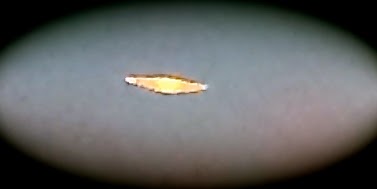Explanation:
The city of Veszprem, Hungary was only briefly haunted by
this mysterious spectre.
On the morning of August 11, its monstrous form hovered
in the mist above municipal buildings near the town center.
A clue
to its true identity is offered by the photographer, though,
who reports he took the picture from the top of a twenty story building
with the rising Sun directly at his back.
That special geometry suggests this is an example of
an atmospheric phenomenon called
the Glory or sometimes
"the
Spectre of the Brocken".
Also seen from mountain tops and airplanes when looking opposite
the Sun, the dramatic apparition is the observer's shadow on
clouds or fog, the small droplets of water scattering
light back towards the Sun through
complex
internal reflections.
Careful night sky watchers can also encounter this spectre's analog
in astronomy, a brightening of zodiacal light opposite the Sun
known as the gegenschein.
Explanation:
It was visible around the world.
The sunset conjunction of Jupiter and Venus in 2012 was visible almost
no matter where you lived on Earth.
Anyone on the planet with a clear western horizon at sunset could see them.
Pictured above in 2012, a creative photographer traveled
away from the town lights of
Szubin,
Poland to image
a near closest approach of the
two planets.
The bright planets were separated only by
three degrees and his daughter striking a humorous pose.
A faint red sunset still glowed in the background.
Early tomorrow (Monday) morning, the two planets will pass even closer -- only 0.2 degrees apart as
visible from some locations -- just before sunrise.
Explanation:
On Monday morning, Venus and Jupiter gathered close in
dawn
skies, for some separated by about
half the width of a
full moon.
It was their
closest conjunction
since 2000, captured here above the eastern horizon before sunrise.
The serene and colorful view
is from Istia beach near the city of Capoliveri on the island
of Elba.
Distant lights and rolling hills are along Italy's Tuscan coast.
Of course, the celestial pair soon wandered apart.
Brighter Venus headed lower, toward the eastern horizon and
the glare of the Sun, while Jupiter continues to rise a little higher
now in
the sky near dawn.
The two brightest planets
meet
again next June 30th, in the
evening twilight above the western horizon.
Contrasting Terrains on Comet Churyumov-Gerasimenko
Image Credit:
ESA /
Rosetta / MPS for
OSIRIS Team;
MPS/UPD/LAM/IAA/SSO/INTA/UPM/DASP/IDA
Explanation:
Where should Philae land?
As ESA's robotic
spacecraft Rosetta circles toward
Comet 67P/ Churyumov-Gerasimenko, a decision must eventually be made as to where its mechanical lander should attempt to touch-down.
Reaching the comet earlier this month,
Rosetta is sending back detailed pictures of the
comet's unusual nucleus from which a smooth landing site will be selected.
Pictured above,
near the image top, the head of the comet's nucleus shows rugged
grooves, while near the image bottom, the body shows a patch-work of
areas sometimes separated by
jagged hills.
Some of the patch-work areas apparent on both the
head and body seem
to have fields of relatively smooth terrain.
In the connecting area called the neck, however, visible across the
image center, a relatively large swath of light-colored smooth terrain
appears, punctuated occasionally by
large boulders.
Rosetta is scheduled to release
Philae toward the
dark mountain-sized
comet nucleus with an anticipated landing date in November.
Explanation:
What's that dot on the Sun?
If you look closely, it is almost perfectly round.
The dot is the result of an unusual type of
solar eclipse that occurred in 2006.
Usually it is the
Earth's Moon that eclipses the Sun.
This time, the planet
Mercury
took a turn.
Like the approach to New Moon before a
solar eclipse,
the phase of Mercury became a continually thinner
crescent as the planet
progressed toward an alignment with the Sun.
Eventually the phase of
Mercury dropped to zero and
the dark spot of Mercury crossed our parent star.
The situation could technically be labeled a Mercurian
annular
eclipse with an extraordinarily large
ring of fire.
From above the
cratered planes
of the night side of Mercury, the Earth appeared in its fullest phase.
Hours later, as Mercury continued in its orbit, a slight
crescent phase appeared again.
The next Mercurian solar eclipse
will occur in 2016.
Arp 188 and the Tadpole's Tail
Image Credit:
Hubble Legacy Archive,
ESA,
NASA;
Processing & Copyright:
Joachim Dietrich
Explanation:
Why does this galaxy have such a long tail?
In this stunning vista, based on image data from
the Hubble Legacy Archive,
distant galaxies form a dramatic backdrop
for disrupted spiral
galaxy
Arp 188, the Tadpole Galaxy.
The cosmic tadpole is
a mere 420 million light-years distant toward the
northern constellation Draco.
Its eye-catching tail is about 280 thousand light-years long and
features massive, bright blue star clusters.
One story goes
that a more compact
intruder galaxy crossed in front
of Arp 188 - from right to left in this view - and was
slung
around behind the Tadpole by their gravitational attraction.
During the
close encounter, tidal forces drew out the
spiral galaxy's stars, gas, and dust
forming the spectacular tail.
The intruder galaxy itself, estimated to
lie about 300 thousand light-years behind the
Tadpole,
can be seen through foreground spiral arms at the upper right.
Following
its terrestrial namesake, the Tadpole Galaxy will likely lose
its tail
as it grows older, the tail's star clusters
forming smaller satellites of the large spiral galaxy.















































